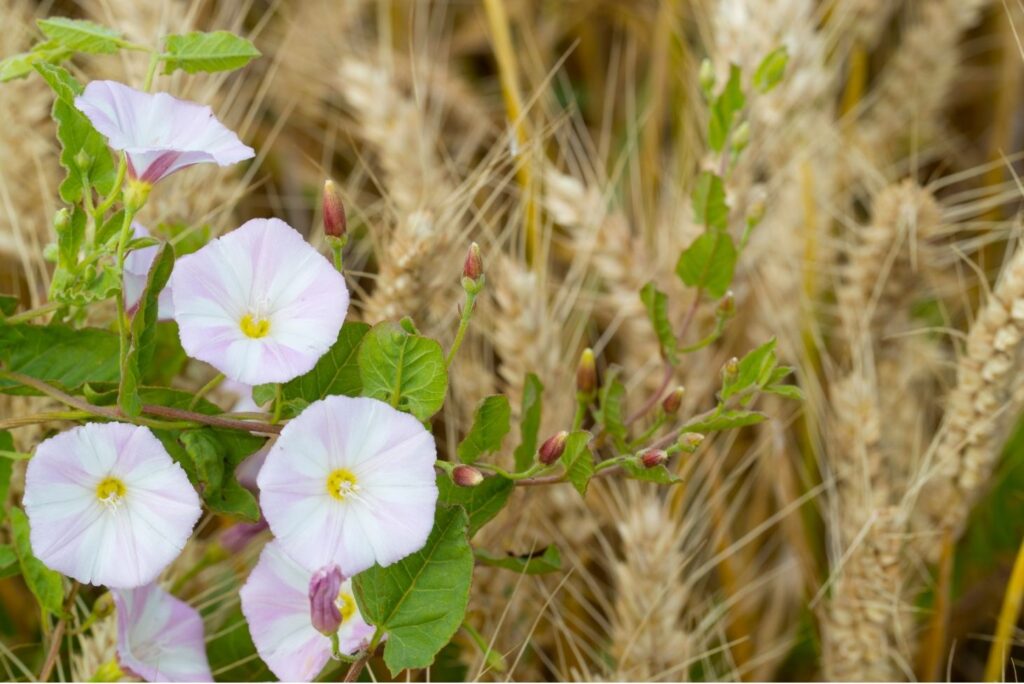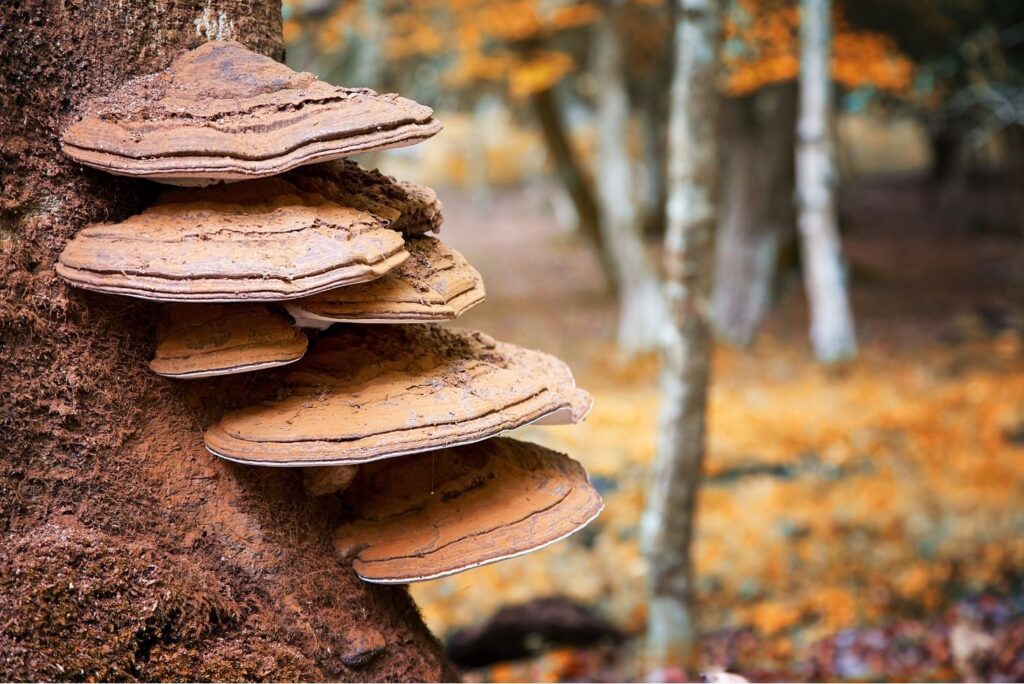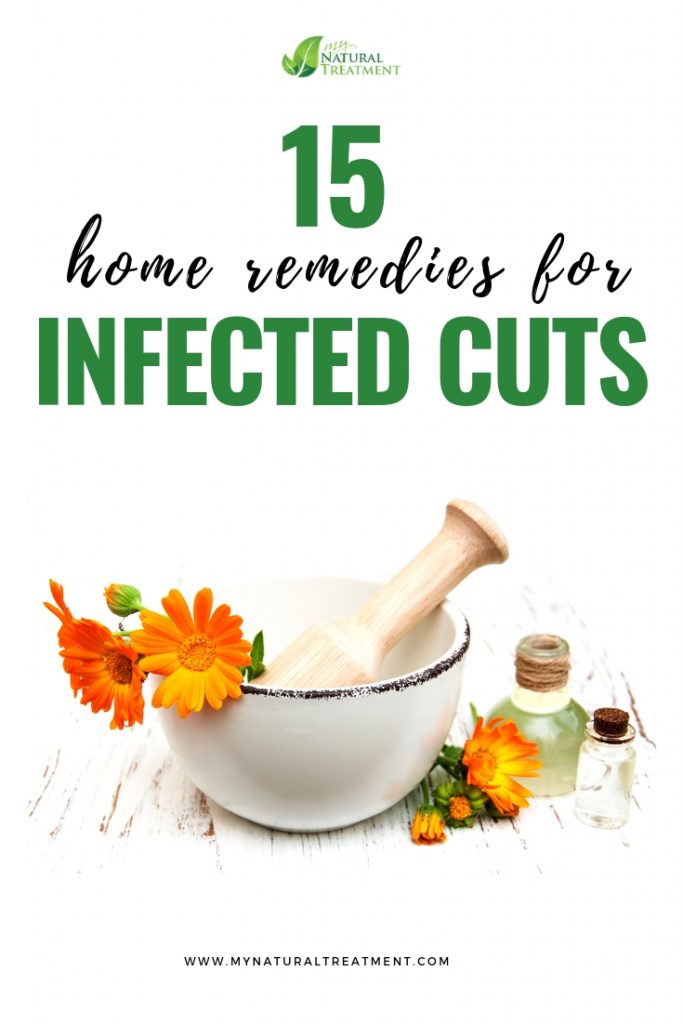If you are looking for simple and effective home remedies for infected cuts, continue reading this article and find out what they are. But first.
Infected cuts left untreated can lead to septicemia and other complications. This is why, when you get cut, you need to move quickly and apply an ice cube to the cut. Then apply camphor alcohol-infused poultice or a poultice with leopard’s bane decoction (10 g per 200 ml hot water). However, if the cut is deep and infected, look into one of the home remedies for infected cuts below. But first, how do cuts get infected?

In This Article You Will Find:
Why Do Cuts Get Infected
There are very many ways in which you can get an infected cut, by cutting with a blade or with a piece of glass, barbed wire, or everything that might lead to cuts that get infected. When left untreated, cuts can get severely infected and in the worst-case scenario, when the infection gets into the blood, one can develop septicemia. Our advice is to never ever leave cut wounds untreated. You can prevent infected cuts with the help of the simple home remedies for infected cuts below. Before we get to them, previous to using any of the home remedies for infected cuts here, wash your hands clean, and then the cut with clean water and 100% organic soap.
15 Home Remedies for Infected Cuts
1. Cabbage Home Remedies for Infected Cuts
Cabbage is perhaps the best remedy that you can use for infected cuts. You can prepare wonderful balms and poultices with cabbage in case of a wound that got infected. First, we want to share with you an amazing cabbage balm, one of the oldest home remedies for infected cuts from the Bessarabia region located in Eastern Europe.
Cabbage Balm for Infected Cuts
- Combine together 100 ml of fresh cabbage juice, 1 tsp of honey, and 1 tsp of grains alcohol in a saucepan. Bring to a simmer, but remove right when the content starts to simmer.
- In another saucepan combine 1 tbsp of pork fat, 1 tsp of beeswax, and 2 tsp of corn sprouts, and bring to a simmer. Stirr well, but again, don’t let the ingredients start to boil.
- Remove from the fire and combine the two preparations together.
- Continue mixing until the cabbage juice balm starts to cool down.
- Immediately after it has cooled down, pour the fresh cabbage balm into small glass containers or small cream jars, and keep them in the fridge. The cabbage balm has a storage life of 2-3 months if kept in a cool place.
Use the balm to anoint the infected cuts several times per day. In addition to the cabbage balm, there’s another way to use cabbage for infected wounds. That is cabbage and cottage cheese cataplasms. This is how you can prepare this remedy for infected cuts at home.
Cabbage & Cottage Cheese Cataplasm
Take one large cabbage leaf and wash it really well. Cut off the thick leaf nervures and crush the leaf a little using a dough roller. Heat up some water in a pot until it reaches 45-60°C temperature. Soak the leaf once in this water for 3-4 seconds, remove it, and soak it once again. Combine 150 g of cottage cheese with 1 tbsp of honey. Spread the cottage cheese mix onto the cabbage leaf and apply the leaf to the infected cut/s. The cabbage juice balm and the cabbage and cottage cheese poultice are some of the best home remedies for infected cuts.

2. Field Bindweed Remedy for Infected Cuts
Field bindweed (Convolvulus arvensis) blooms in the summer months and it is one of the most effective home remedies for infected cuts and also hematoma. In case of cuts that got infected, you can use field bindweed infusion for topical washes. To prepare this disinfecting infusion, follow the simple recipe below.
- Steep 1 full tbsp of the minced plant in 200 ml of hot water.
- Strain and use the infusion to wash the cuts and even for bandaging them.
Field bindweed flowers are miraculous in themselves for cleaning and healing cuts. Another way to use them is to crush them and apply them directly to the cut or wound as a cataplasm. If the cut is already infected when you use this remedy, you will experience this strange sensation as if someone was pulling small threads out of the cut, but the sensation will disappear in a few minutes, so don’t worry. Change the flowers with new ones, 3-4 times per day.
Hops basically have the same effect as field bindweed if you prepare it by steeping 10 g of hops into 200 ml of hot water until the water has chilled. Apply the hops infusion on a cataplasm on the infected cuts and change it several times a day. These two flowering herbs are some of the best and most effective home remedies for infected cuts.

3. Garlic Remedy for Infected Cuts
One of the best home remedies for infected cuts is garlic. For this remedy, you need fresh green garlic (the one that looks like a slightly overgrown scallion or green onion) and not dried garlic or garlic cloves. Smash the green garlic using a pestle, pour the juice onto a bandage and apply it directly to the infected cuts. As we all know by now, garlic is one of the most powerful natural antibiotics that prevent infection and further complications. This is why garlic is one of the best home remedies for infected cuts.
4. Home Remedies for Infected Cuts with Milk
Pour 1 liter of milk into an enameled pot. Simmer the milk until it starts to bubble and rise up for about 1-2 cm, then remove from the heat. Don’t break the milk foam that starts to rise up, this is very important! After the milk has cooled down, pour it into another enameled pot and simmer again as previously. Repeat this procedure 5 times. Use very clean pots for each boil.
Separately, peel one red potato and chop it finely using a stainless steel knife. Add the chopped potato into the milk, at the fifth and final boil. Mix well until the potato and the milk form a paste. Leave the composition to cool down. Apply this paste in a 1 cm (half an inch) thick layer to the infected cuts or bruises. Then bind the cataplasm using a sterile piece of gauze. Keep the milk and potato cataplasm on for 2 days and 2 nights straight. After removing it, wash the wound with hydrogen peroxide. Repeat until the cuts are completely healed.
There is another remedy for infected wounds that uses milk and flax seeds this time. Here is the recipe.
Grind 1 cup of flax seeds using the coffee grinder. Bring a pot of milk to boil on the fire. When it starts to simmer, add the ground flax seeds, and after a few simmers, remove the pot from the fire. Now add 1 tbsp of honey and mix well. Apply the obtained paste on a sterile bandage and place it on the infected cut as hot as you can possibly bear. Change it with a new poultice until all the infection is gone. This is a very quick home remedy for infected cuts and wounds. Milk and potatoes are, indeed, amongst the best home remedies for infected cuts.

5. Aloe Vera Quick Remedy for Infected Cuts
Another great home remedy for infected cuts is Aloe Vera, a plant known to heal skin tissue and help the regeneration of new tissue cells. Add a few Aloe Vera tincture drops to a small basin filled with water and wash your cut with the Aloe water. To quicken the recovery, blend a piece of fresh Aloe Vera Barbadensis leaf gel into your daily fruit smoothies. Aloe is one of the most powerful home remedies for infected cuts.
6. Rye Bread Remedy for Infected Cuts
This is perhaps the oldest and most effective folk remedy for skin infections and cuts that has saved many limbs from amputation since very old times. Here it goes. Sprinkle a lot of natural salt on a piece of organic rye bread. Chew the bread until the bread gets soaked with your saliva. Use the obtained paste to apply to the infected cuts and bandage tightly. This remedy is known for its effectiveness in poisoned blood and as gangrene treatment. In addition, it is one of the simplest home remedies for infected cuts.
7. Beech Tinder Powder Remedy for Infected Cuts
Pick some beech tinder (Fomes fomentarius), the mushroom that grows on the beech tree’s bark in the months of September and October. Cut it up in 1 cm thick slices. Put them to sun dry and when completely dried, grind them as finely as possible. Use the fungus powder to sprinkle on the infected cuts that have a hard time healing. In case of emergency, when you get badly cut while hiking in the forests, apply a piece of beech tinder to the cut and tie it in place. This will stop the bleeding right away.

8. Folk Remedy for Infected Cuts with Egg Shells
First of all, you need to disinfect the cut really well with water and natural soap, your own urine, hydrogen peroxide, or any other natural disinfectant. Then cover the cut with the inner skin inside a raw egg. Apply it with the moist side on the cut and then bandage tightly to seal the cut and stop the bleeding. Keep the bandage on for a few days, while the egg skin dries and sticks to the skin. Leave the egg skins on, until they fall off on their own. Another folk remedy for infected cuts is onion and clay.
Combine together 1 chopped onion and 1 tbsp of chopped plantain leaves and then add the same quantity of honey. Apply as cataplasm on the infected cut and change it 3 times per day. Or you can use clay as follows. Soak a bit of clay in apple cider, homemade wine, or salted water (made by dissolving 25 g of salt into 250 ml of water). If you don’t have clay at your disposal, soak a clean towel in salted water and apply it to the cuts. While it may sound simple, this is one of the most effective home remedies for infected cuts.
9. Common Lady’s Mantle Tea Remedy for Cuts
Wash the cuts several times a day with common lady’s mantle tea and then anoint the wounds with a simple salve made with pork or sheep lard and natural salt. This is one of the most powerful home remedies for infected cuts from parts of Eastern Europe.

10. Cinnamon Remedy for Infected Cuts
Sprinkle cinnamon powder on the cuts and bandage with a thin piece of gauze. Wash the wound daily and let it dry on its own. Then sprinkle the cinnamon powder and tie it back again. Cinnamon is a powerful natural antibiotic, which is why this is one of the best home remedies for infected cuts.
Read Also: 14 Natural Remedies for Open Wounds
We really hope that these powerful home remedies for infected cuts will help you get rid of the infection and avoid any further complications. Let us know what is your go-to remedy for infected cuts, or what has worked for you in the comments below. Stay healthy, naturally!

